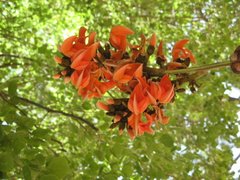YANGON (Reuters) - At least 5,000 monks and nuns, applauded by thousands of onlookers, marched in Yangon on Sunday, the largest demonstration yet in Myanmar in a rare wave of protests against the ruling generals.
A day after a dramatic appearance of support for the marchers by detained democracy icon Aung San Suu Kyi, monks prayed at the Shwedagon Pagoda in Yangon, devoutly Buddhist Myanmar's holiest shrine, then marched through the city.
About 100 nuns joined one band of more than 2,000 monks, then marched to the centre of the former capital.
It was one of five protest marches by monks in the city and there were at least two in Mandalay, a major centre of the monkhood, ahead of a quarterly summit of the generals who have ruled the former Burma for 45 years.
There were no signs of trouble at Sunday's protests.
Plainclothes police kept watch, but there were no uniformed officers or soldiers in sight and people on the streets applauded as the marchers passed.
Protest marches by monks have become more regular, a sign that what began as civilian anger at last month's shock fuel price rises is becoming a more deep-rooted religious movement against the generals.
In New York, U.S. Secretary of State Condoleezza Rice expressed sympathy for the protesters and denounced the military.
"The Burmese people deserve better. They deserve (the) right to be able to live in freedom, just as everyone does," she said.
"The brutality of this regime is well known and so we'll be speaking about that and I think the President (George W. Bush) will be speaking about it as well," she told reporters.
The mood was cheerful in Yangon, with many people seeing the emergence of Suu Kyi from her lakeside villa as a sign the military, which has put down a 1988 uprising ruthlessly, was being flexible.
"OVERWHELMING"
It was the first time she had been seen in public since her latest detention began in May 2003. For many onlookers, already stunned by police allowing marching monks through the barricades sealing off her street, it was overwhelming.
Wearing an orange blouse and a traditional wraparound skirt, she emerged from a small door in the iron gate to the house, her hands held palm to palm in a gesture of Buddhist supplication.
"Some of us could not control our tears," one witness told Reuters after 1,000 monks held a 15-minute prayer vigil at the house to which Suu Kyi is confined with no telephone and needing official permission, granted rarely, to receive visitors.
However, on Sunday, the barbed-wire barricade at the entrance to her street was reinforced by four fire engines, several police vans and dozens of police carrying riot shields who refused to allow a group of 200 marching monks through.
News of Suu Kyi's appearance incident spread rapidly on a day when the monks marched despite Yangon being lashed by 11.54 inches (29.31 cm) of rain, the highest recorded in 39 years.
"The monks showed their courage, strong determination and discipline while the regime showed flexibility," a retired government official said. "I think this incident has shown us that we can sort out any problem among us amicably."
The generals are due to hold a quarterly summit in their new capital of Naypyidaw, carved out of the jungle, perhaps as early as Monday. Dealing with the protests is sure to top the agenda.
The protests, which began on August 19 after huge fuel price increases prompted a midnight round up of the democracy activists who organised them and now face up to 20 years in jail, appear far from over.
On Sunday, a group of monks, one of them wielding a bullhorn, chanted a new slogan: "Our uprising must succeed".
A group calling itself the All Burma Monks Alliance urged ordinary people for the first time "to struggle peacefully against the evil military dictatorship" until its downfall.
By Aung Hla Tun
Subscribe to:
Post Comments (Atom)


No comments:
Post a Comment